Paper Guide
In this guide, we’re looking at the three main factors that determine what paper choices you make when ordering print:
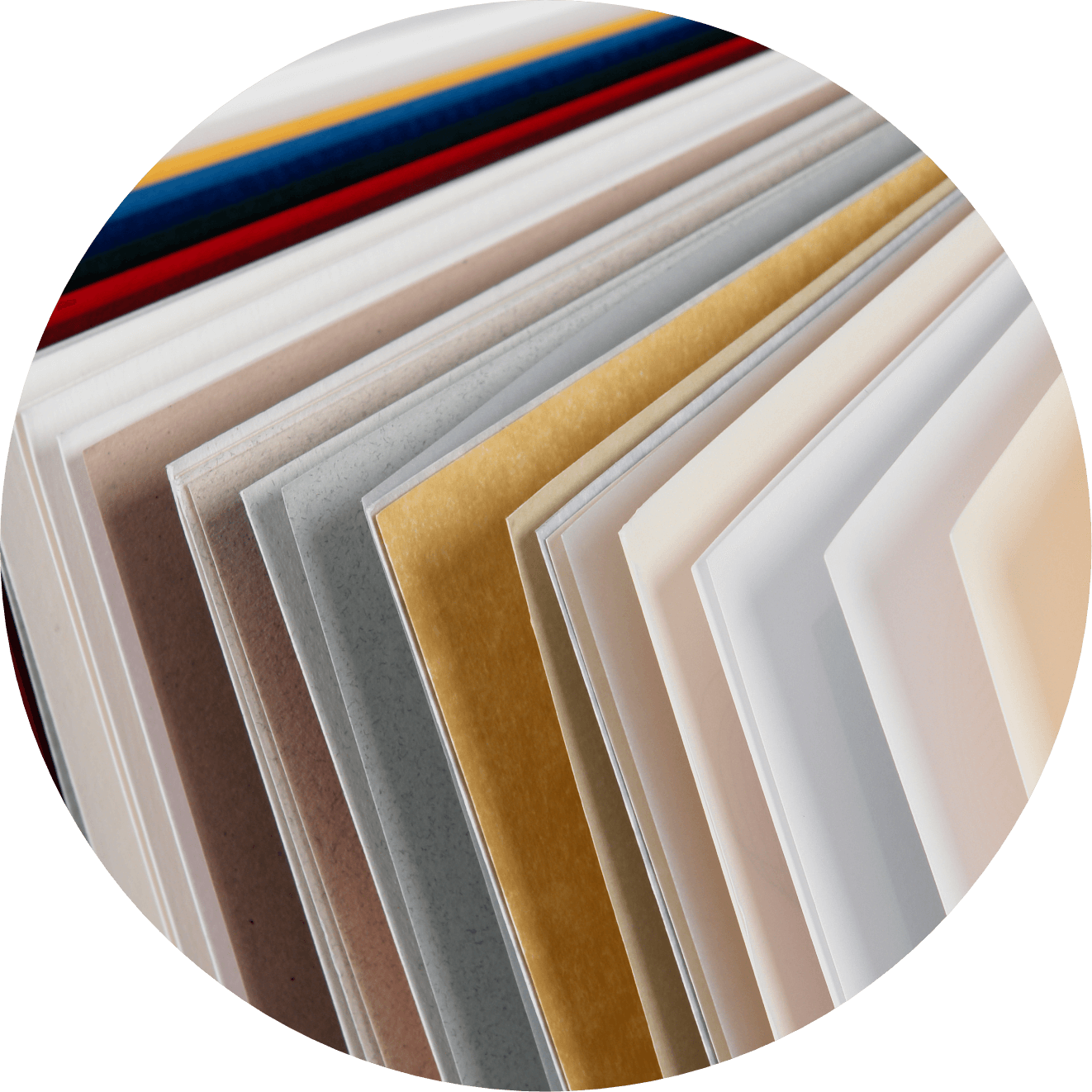
Paper weights
The standard way of expressing the thickness and density of paper is to refer to its “weight”. Paper is given a weight value expressed as “gsm” or Grams per Square Meter. This figure gives the weight of one square meter of the paper.
It doesn’t sound like a particularly useful thing to know, but once you get a feel for how the scale works, it’s a useful tool for selecting and ordering your print. A low value indicates a thinner and more flexible paper. A higher value will be a stiffer card. Here’s a rough guide to what weight of paper tends to be used for certain applications:
- Paper between 80 and 100gsm is often used as photocopier paper or for light stationery.
- From 110 to 170gsm, we find higher quality stationery like Letterheads and Compliments Slips. Within that range, 130gsm is a good starting point for Flyer and Leaflets.
- Anything beyond 200gsm is classed as “board” in the industry, and would most likely be referred to as card.
- Once we get into the 300s, we find appropriate weight board for products such as Wedding Invitations, Greetings Cards that are able to support their own weight and free-standing Table Talkers.
- At 400gsm and beyond, we find stiff and sturdy board. Business Cards and Loyalty Cards are often around the 400gsm mark, while 457gsm Kraft board, makes for satisfyingly rugged Swing Tags and Postcards.
- Our Triple Layer products such as Triple Layer Business Cards, Triple Layer Swing Tags, Triple Layer Bookmarks and Triple Layer Postcards weigh in at a hefty 810gsm. You can learn more about these products in our Triple Layer Guide.
- Thicker materials than this tend to be measured in microns, a unit of length that equates to a thousandth of a millimetre. Our Beer Mats for example are 1.4mm, or 1400mic thick. Our Strut Cards are printed on 2000mic board.
Standard paper types
Our core range of standard paper types are Bond, Silk, Gloss, Pulp and Recycled. Each of these provides an opaque, white background for your print, but they also have distinguishing properties of their own that set them apart.
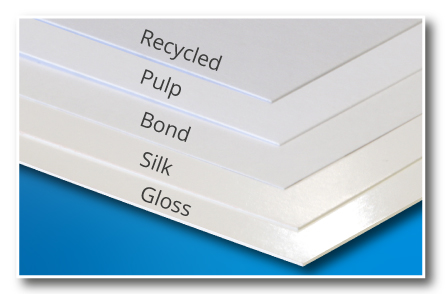
Bond
Originally, this was the paper of choice for important documents such as government bonds. It gets its name from being the preferred paper type for government bonds and other legal and official documents.
Appearance
Bond is an uncoated paper with a matt finish. The lack of sheen means there’s no distraction from the printed content.
It has an even feel and looks smooth to the eye, but Bond paper has a subtle texture that gives it character. The result is a greater, more porous surface area that helps it take on inks from either the press or the pen.
Uses
It’s a great all-round paper stock for personal and commercial applications. The versatile nature of Bond makes it ideal for office stationery where your Letterhead may be printed professionally, your letter itself printed on an office printer and your signature written in pen.
Popular uses for Bond paper include Envelopes, Letterheads, Compliment Slips and Posters.
Pros
- Matt surface displays print vividly
- Absorbent surface that performs well with all types of inks
- Easy to write on with pen and pencil
- The perfect paper for overprinting
- Subtle texture
Cons
- Uncoated paper may struggle to stay fresh with repeated use
Gloss
Gloss paper achieves a high sheen without the need for lamination. The gloss surface helps to bring out bright colours in print, results in luxurious and professional print products.
Appearance
If you want to produce images and text with brilliant colour and perfect definition, gloss paper ensures a crystal-clear end product. The polished finish provides a lustrous shine that highlights colours and creates a striking impact.
Uses
Use gloss when producing materials that express quality and sophistication. In addition to making your message shine, gloss paper is less susceptible to moisture and damage, staying fresher longer.
Popular uses for Gloss paper include Flyers & Leaflets, Posters, Brochures and Placemats.
Pros
- High-sheen for visual impact
- Adds glamour to Brochures and Magazines
- More durable and resistant to moisture than other unlaminated stocks
Cons
- Reflective finish may produce glare when displayed in sunlight
- Not the easiest to write on as ink may smudge
- Not suited to overprinting
Silk
Silk paper provide high-quality colour reproduction and a luxurious feel without the high shine of gloss. It’s a versatile stock that lends itself to a wide variety of print products from Posters to Calendars.
Appearance
Silk paper sits between gloss and matt on the shininess spectrum. It shares the smooth texture of Gloss, minus the glassy reflective finish. It’s softer and more even to the touch than Bond, with a subtle satin sheen.
Uses
Silk’s soft texture makes it ideal for a huge range of applications. It’s also an inexpensive stock, so at lighter weights, it’s a great choice for high quantities of Flyers, while 400gsm Silk produces long-lasting yet cost-effective Business Cards.
Popular uses for Silk paper include Flyers & Leaflets, Business Cards, Calendars and Postcards.
Pros
- Brings a subtle shine without reflective glare
- More durable than Bond
- Can be written on
- Cost-effective
Cons
- Not the best for overprinting
Uncoated
We use uncoated paper as an equivalent to Pulp, providing an unfinished feel that’s ideal for those who value a natural, authentic look or who need a writable surface.
Appearance
The smooth yet unfinished surface is perfect for brands that emphasise sustainability and a genuine connection with their audience. Brighter designs will appear subtly muted, owing to the way the ink absorbs into the paper.
Uses
Popular uses for Uncoated paper include Greeting Cards, Posters, Flyers & Leaflets and Business Cards.
Pros
- Well-suited to overprinting
- Easy to write on
Cons
- Unfinished so less longevity with repeated use
- A less polished surface
Recycled
The recycled paper stock we use is manufactured from certified sustainable pulp sources and produced in a carbon-neutral way. Production meets the following standards and awards:
- EU Ecolabel - European environmental award for overall environmental performance
- ISO 14001 - International standard for environmental management
- ISO 9001 - International standard for quality management
Appearance
Unlike recycled paper stocks in the past, this stock has levels of opacity, smoothness, and whiteness that rival stocks created from virgin pulp.
Uses
Recycled paper is incredibly versatile and is used throughout the Solopress Green range, including Eco-Friendly Business Cards, Recycled Flyers & Leaflets and more.
Pros
- Manufactured from 100% post-consumer waste pulp
- Carbon-neutral production
Cons
- Some differences in look and feel with non-recycled paper stocks
Specialist paper types
In addition to the industry-standard paper stocks listed above, we also offer a range of speciality paper types, each with distinctive qualities that can add a quirky edge to your print.
Triple Layer
Creating Triple Layer Business Cards, Swing Tags, Bookmarks or Postcards not only increases the thickness to a substantial 810gsm, but it also gives you the option of choosing a different coloured card for the central layer. This produces a stylish pinstripe around the edge. Our Triple Layer Guide features everything you need to know about ordering these striking products.
Textured Dot
An interesting feel can also be achieved by using a paper stock that has been produced to feature its own texture. Products such as our Textured Dot Business Cards feature raised dots in a regular pattern across the surface.
Textured Tweed
Another stock to consider for Textured Business Cards is tweed. This surface of this stock has the look and feel of a woven textile, perfect for fashion and haberdashery, but also any creative industry where you want to show your imaginative side.
Metallic
Not to be confused with Foiling (see Finishes below), Metallic Business Cards are printed on special iridescent paper stocks. The natural lustre of the paper stock shines through your design and lifts your artwork. We offer a range of four different metallic paper stocks: gold dust, gold haze, damask blue and petal pink.
Day-Glo
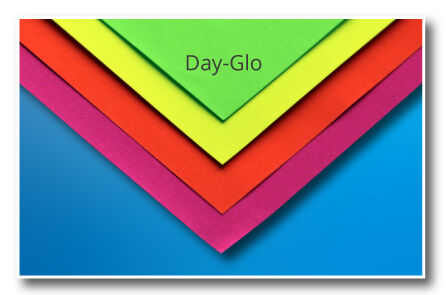
Day-Glo Posters, in particular, are a popular choice for outdoor displays. If you want to promote an event, Day-glo Posters grab their attention and ramp up the anticipation. We offer a choice of Fluorescent green, orange, pink or yellow to provide the backdrop to promote concerts, gigs, club nights and promotions. Our blog about how to design a Day-Glo Poster has some great tips for an effective poster campaign.
Brown Kraft
Providing a rustic matt finish, this raw, earthy stock is understandably popular with brands that lean towards vintage, homemade, organic or eco-friendly values. The environmental theme is backed up by the fact that Brown Kraft paper is 100% recycled and recyclable.
It should be noted that the brown material will show through on blank areas in your design, and vivid colours may be tempered by the darker background. You can learn all about designing for this material in our Kraft Paper Guide.
Synaps
Synaps is a waterproof, tearproof, washable material that’s PVC-free, fully recyclable polyester. It’s bright, opaque and can be printed just like paper – but it’s also tough, strong and immune to the elements. That means they can survive multiple uses without rippling in the rain or fading in the sun.
Ideal for reusable Waterproof Menus, Placemats and Posters, when your Synaps product has finally completed its job, it can be disposed of in your PET plastic recycling.
Finishes
Many of the paper types mentioned can also be finished in a variety of ways to protect your print and make it pop.
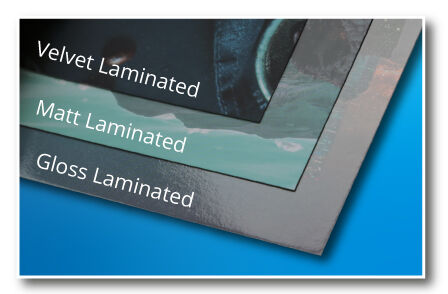
Gloss Lamination
Offering glassy shine and a tough protective layer, Gloss Lamination is a great high-quality finish that makes your bright colours ping off the page. Adds a luxury finish to a huge range of products like Postcards, Business Cards and Bookmarks.
Matt Lamination
The laminated finish adds a layer of protection to leaflets without the glossy surface, perfect for darker colours, understated messages or times when you want to avoid glare from bright light sources. Perfect for Business Cards, or on the covers of your Brochures and Magazines.
Velvet Lamination
Tough yet soft to the touch, Velvet Lamination not only Increase longevity and durability but offers a unique and pleasing feel under the fingers. Ideal for products that are designed to be handled like Presentation Folders, Leaflets and Business Cards.
Spot UV
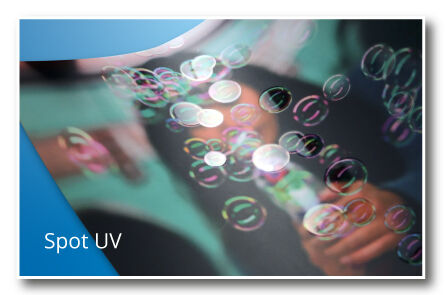
A striking finish doesn’t have to cover the whole of your print. With Spot UV, you can pick out certain areas, patterns, images or text in a high-gloss varnish. This process produces dazzlingly distinct areas on the surface that create both a unique look and a contrasting texture.
Try highlighting your brand name or logo on Business Cards or Flyers & Leaflets. Take a look at our Spot UV Artwork Guide for tips on getting the most out of this approach.
Foil

In a similar way to spot UV, foiling is able to highlight certain areas in your design and bring them to the fore. Rather than gloss varnish, foiling creates metallic accents in your choice of gold, rose gold or silver.
You can put this finish to use with great effect on Foil Business Cards, sprinkle some seasonal shine with Christmas Cards or add a sense of occasion by adding foiling to your Invitations. Our Foil Artwork Guide tells you everything you need to know about designing and ordering your fantastically foiled print.
Need Help?
Following these guidelines ensures that there will be no delays with your printing. If you have any problem, please don't hesitate to call our team on 01702 460047 who will be more than willing to help.
